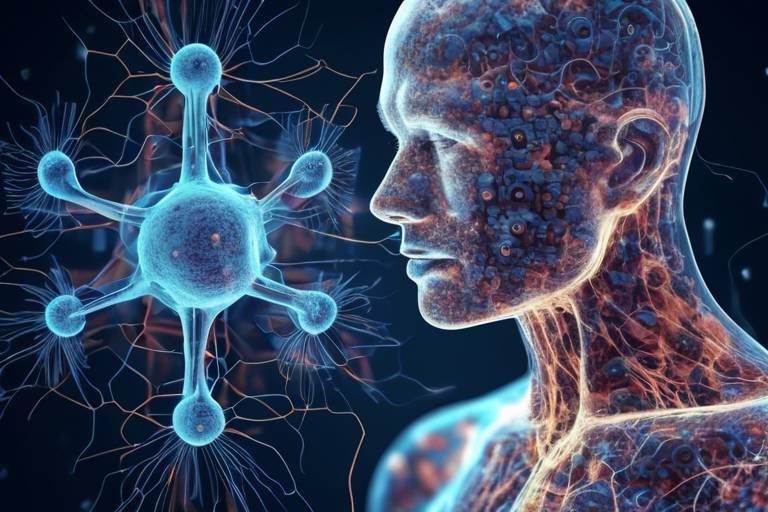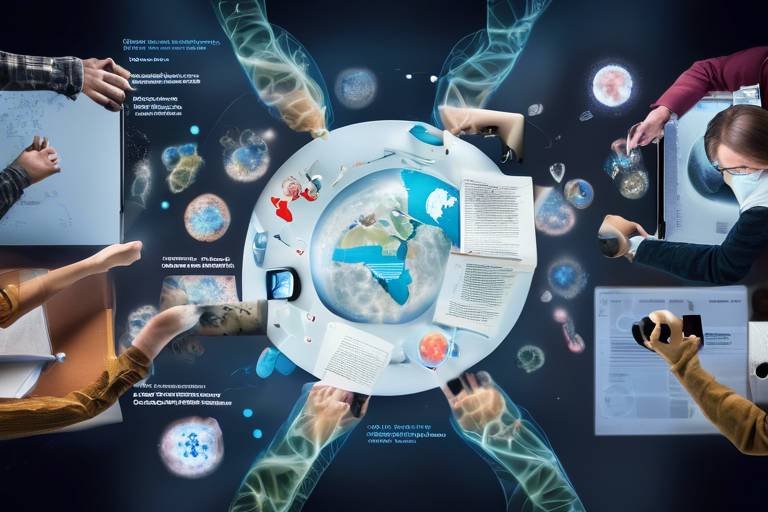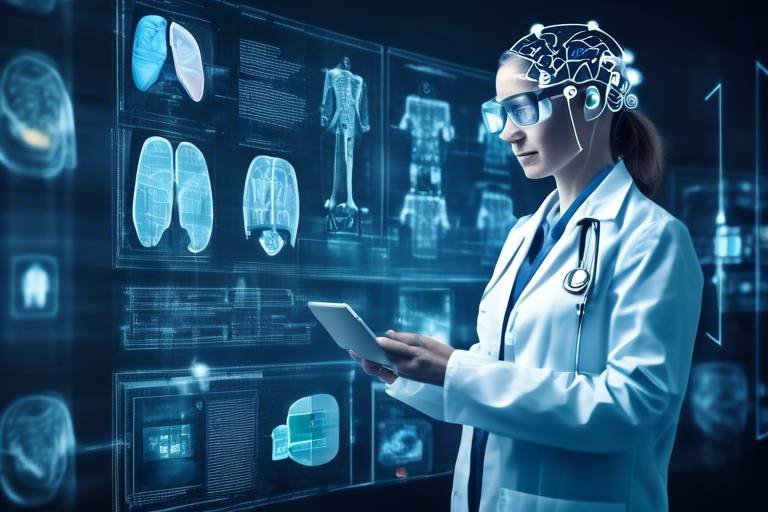The Influence of Machine Learning on Scientific Analysis
In recent years, machine learning has emerged as a transformative force in the realm of scientific analysis, reshaping how researchers approach data and derive insights. Imagine a world where scientists can sift through mountains of data in a fraction of the time it would take using traditional methods. This is not just a dream; it is a reality made possible by machine learning. By leveraging algorithms that can learn from and make predictions based on data, researchers across various disciplines are experiencing a paradigm shift in their methodologies, leading to more accurate results and faster discoveries.
The beauty of machine learning lies in its ability to handle large datasets that are often too complex for conventional statistical techniques. Think of it as a powerful magnifying glass that allows scientists to see patterns and correlations that were previously hidden. Whether it's in biomedical research, environmental science, or physics, machine learning is enhancing the way data is processed, modeled, and analyzed. This article delves into the myriad ways machine learning is revolutionizing scientific analysis, providing a glimpse into the future of research and discovery.
As we explore the applications of machine learning in various fields, we will uncover how it not only enhances data processing but also opens new avenues for predictive modeling and innovative research methodologies. From forecasting patient outcomes in healthcare to analyzing climate data for sustainability, the implications of machine learning are profound. The journey through this article will highlight key breakthroughs, real-world applications, and even the challenges faced by scientists as they embrace this cutting-edge technology.
So, buckle up as we embark on this exploration of the influence of machine learning on scientific analysis. It’s a thrilling ride filled with surprises, insights, and a look at how the future of science is being shaped by data-driven decision-making. Are you ready to dive into the world where algorithms meet discovery? Let’s go!
- What is machine learning?
Machine learning is a subset of artificial intelligence that enables systems to learn from data and improve their performance over time without being explicitly programmed. - How is machine learning used in scientific analysis?
Machine learning is used to analyze large datasets, identify patterns, make predictions, and enhance research methodologies across various scientific disciplines. - What are some challenges of using machine learning in research?
Challenges include data quality issues, algorithm bias, and the need for interdisciplinary collaboration to effectively implement machine learning solutions. - Can machine learning replace traditional research methods?
While machine learning enhances traditional methods, it is not a replacement. Instead, it complements them, allowing scientists to achieve better outcomes and insights.

Understanding Machine Learning
Machine learning (ML) is not just a buzzword; it's a transformative force reshaping how we interact with data. At its core, machine learning is a subset of artificial intelligence that empowers systems to learn from data, identify patterns, and make decisions with minimal human intervention. Imagine teaching a child to recognize animals by showing them pictures; similarly, machine learning algorithms learn from data inputs to make predictions or classifications.
The fundamental concepts of machine learning revolve around three main types: supervised learning, unsupervised learning, and reinforcement learning. In supervised learning, the algorithm is trained on a labeled dataset, meaning that the input data comes with the correct output. For instance, if we want to teach a machine to identify cats in images, we would provide it with numerous images labeled as "cat" or "not cat." In contrast, unsupervised learning deals with unlabeled data, allowing the algorithm to find hidden patterns or intrinsic structures in the data without explicit guidance. This method is akin to exploring a new city without a map; you discover things as you go along. Lastly, reinforcement learning is a type of learning where an agent learns to make decisions by taking actions in an environment to maximize some notion of cumulative reward, similar to how a child learns through trial and error.
One of the key differences between machine learning and traditional statistical methods lies in the approach to data. Traditional statistics often rely on predefined models and assumptions about the data distribution, while machine learning focuses on letting the data speak for itself. This flexibility enables machine learning to handle large and complex datasets, making it particularly effective in fields like healthcare, finance, and environmental science.
To better understand how machine learning operates, let’s explore some common algorithms used in the field:
| Algorithm | Description | Use Cases |
|---|---|---|
| Linear Regression | Predicts a continuous outcome based on the relationship between variables. | Real estate pricing, stock price forecasting. |
| Decision Trees | Uses a tree-like model to make decisions based on feature values. | Customer segmentation, credit scoring. |
| Neural Networks | Simulates the human brain's interconnected neuron structure to process data. | Image recognition, natural language processing. |
| Support Vector Machines | Finds the best boundary that separates different classes in the data. | Text classification, bioinformatics. |
As we delve deeper into the world of machine learning, it becomes clear that its potential is vast and its applications are numerous. From enhancing the accuracy of predictions to automating complex tasks, machine learning is changing the landscape of scientific analysis. Whether it’s predicting weather patterns or discovering new drugs, the implications of machine learning are profound and far-reaching.
In summary, understanding machine learning involves grasping its core concepts, differentiating it from traditional statistical methods, and recognizing the algorithms that drive its capabilities. As we continue to explore its applications across various scientific domains, the excitement around machine learning only grows, promising a future where data-driven insights lead to groundbreaking advancements.

Applications in Biomedical Research
Machine learning is nothing short of a game-changer in the realm of biomedical research. It’s like having a supercharged assistant that can sift through mountains of data, uncovering insights that would take humans years to discover. Imagine trying to find a needle in a haystack, but instead of just looking for that needle, you have a machine that can identify all the hay that isn’t a needle, making your search infinitely more efficient. This is exactly how machine learning enhances the research landscape!
One of the most exciting applications of machine learning in biomedical research is in the area of drug discovery. Traditionally, developing a new drug can take over a decade and cost billions of dollars. However, machine learning algorithms can analyze vast datasets of chemical compounds and biological effects, significantly accelerating the discovery of potential new drugs. For instance, researchers can use machine learning to predict how different molecules will interact with biological targets, narrowing down the candidates that are most likely to succeed in clinical trials.
Moreover, the concept of personalized medicine has gained traction thanks to machine learning. By analyzing patient data, including genetic information, machine learning models can help tailor treatments to individual patients. This means that instead of a one-size-fits-all approach, doctors can provide more effective, customized therapies based on the unique characteristics of each patient. It’s like having a bespoke suit instead of a generic outfit; it fits better and looks sharper!
Additionally, machine learning is revolutionizing diagnostic tools. Imagine a system that can analyze medical images, such as MRIs or CT scans, with incredible accuracy. Machine learning algorithms can be trained to detect anomalies that may escape the naked eye, leading to earlier and more accurate diagnoses. This capability not only enhances patient outcomes but also streamlines the workflow for healthcare professionals, allowing them to focus on patient care rather than being bogged down by administrative tasks.
In summary, the applications of machine learning in biomedical research are vast and varied. From speeding up drug discovery to enabling personalized medicine and improving diagnostic accuracy, the influence of machine learning is profound. As we continue to harness the power of this technology, the future of healthcare looks brighter than ever.
- What is machine learning? Machine learning is a subset of artificial intelligence that allows systems to learn from data and make predictions or decisions without explicit programming.
- How does machine learning improve drug discovery? By analyzing large datasets, machine learning can identify promising drug candidates more quickly and accurately than traditional methods.
- What role does machine learning play in personalized medicine? It enables the analysis of individual patient data to tailor treatments specifically to their genetic and health profiles.
- Can machine learning enhance diagnostic tools? Yes, machine learning algorithms can analyze medical images to detect conditions that may be missed by human eyes, improving diagnostic accuracy.

Predictive Modeling in Healthcare
Predictive modeling in healthcare is not just a buzzword; it’s a game-changer. Imagine being able to anticipate patient outcomes and disease progression before they even occur. That’s the magic of machine learning algorithms! These advanced tools analyze historical data and identify patterns that can predict future events. For instance, healthcare providers can assess a patient's risk of developing chronic diseases like diabetes or heart disease based on various factors such as genetics, lifestyle choices, and previous health records. This proactive approach allows for timely interventions and tailored treatment plans, significantly improving patient care.
But how does this work in practice? Let’s break it down. When healthcare professionals input data into a predictive model, the system processes vast amounts of information, searching for correlations and insights that might not be immediately apparent. The algorithms can handle various types of data, from electronic health records (EHR) to genomic data, making them incredibly versatile. This capability leads to more accurate forecasts and helps in decision-making processes.
One of the most exciting aspects of predictive modeling is its ability to enhance patient outcomes. By understanding potential health risks, clinicians can develop personalized treatment strategies. For example, a model might indicate that a patient is at high risk for a particular condition, prompting doctors to initiate preventive measures such as lifestyle changes or medication adjustments. This not only improves the quality of care but also reduces healthcare costs by preventing serious health issues from developing.
However, it’s essential to acknowledge that predictive modeling in healthcare is not without its challenges. Issues such as data quality, algorithm bias, and the need for comprehensive datasets can hinder the effectiveness of these models. For instance, if the data fed into a predictive model is incomplete or biased, the predictions may lead to incorrect conclusions, potentially harming patients instead of helping them. It’s crucial for healthcare professionals to remain vigilant and ensure that the data used is accurate and representative.
In summary, predictive modeling in healthcare is a powerful tool that enhances patient care through informed decision-making and tailored treatment plans. As technology continues to evolve, the potential for machine learning to revolutionize healthcare becomes even more promising. The future is bright, and as we harness the power of data, we can look forward to a world where healthcare is more proactive, personalized, and effective.
- What is predictive modeling in healthcare?
Predictive modeling in healthcare involves using algorithms to analyze data and predict patient outcomes, allowing for proactive treatment strategies. - How does predictive modeling improve patient care?
By identifying potential health risks early, healthcare providers can tailor treatment plans, leading to better outcomes and reduced costs. - What are the challenges of predictive modeling?
Challenges include data quality issues, algorithm bias, and the need for comprehensive datasets to ensure accurate predictions.

Case Studies in Predictive Analytics
Predictive analytics is not just a buzzword; it's a transformative force in the healthcare sector, and various case studies illustrate its remarkable impact. One of the standout examples comes from the partnership between healthcare providers and technology companies, which has led to groundbreaking advancements in patient management and treatment outcomes. Imagine a world where doctors can predict potential health issues before they even arise—this is the magic of predictive analytics in action!
One notable case study involves a large hospital system that implemented a machine learning model to predict patient readmissions. By analyzing historical patient data, including demographics, treatment details, and follow-up care, the model was able to identify patients at high risk of returning to the hospital within 30 days of discharge. The hospital staff could then proactively engage with these patients, providing additional support and resources, ultimately reducing readmission rates by over 20%. This not only improved patient outcomes but also saved the hospital significant costs associated with readmissions.
Another impressive example is found in the realm of oncology. Researchers at a prominent cancer center developed a predictive model that analyzed genetic data, treatment history, and lifestyle factors of cancer patients. The model was able to forecast which patients were most likely to respond positively to specific treatments. This personalized approach allowed oncologists to tailor treatment plans based on predictive insights, leading to improved survival rates and a better quality of life for patients. In fact, the center reported a 15% increase in treatment efficacy as a direct result of implementing this predictive analytics framework.
Moreover, predictive analytics is making waves in managing chronic diseases. A healthcare provider focused on diabetes management utilized machine learning algorithms to analyze patient data, including blood sugar levels, medication adherence, and dietary habits. By identifying patterns and trends, the model could predict potential complications, such as diabetic ketoacidosis, weeks in advance. This early warning system enabled healthcare providers to intervene proactively, adjusting medications and providing necessary education to patients, which significantly reduced hospital visits related to complications.
However, these case studies also highlight the importance of data quality and ethical considerations in predictive analytics. For instance, some models faced challenges due to incomplete or biased data, leading to inaccurate predictions. This emphasizes the need for healthcare organizations to ensure that their data is comprehensive and representative. In addition, as predictive analytics continues to evolve, it is crucial for professionals to remain vigilant regarding algorithmic bias and the ethical implications of using machine learning in patient care.
In conclusion, the case studies in predictive analytics underscore its profound potential to revolutionize healthcare. By leveraging data-driven insights, healthcare providers can enhance patient care, optimize treatment strategies, and ultimately improve health outcomes. As we continue to explore the capabilities of machine learning, the future of predictive analytics in healthcare looks incredibly promising!
- What is predictive analytics?
Predictive analytics refers to the use of statistical algorithms and machine learning techniques to identify the likelihood of future outcomes based on historical data. - How does predictive analytics improve patient care?
By analyzing data, predictive analytics can help healthcare providers anticipate patient needs, tailor treatments, and reduce the risk of complications. - What are some challenges faced in predictive analytics?
Challenges include data quality, algorithm bias, and the ethical implications of using predictive models in healthcare settings. - Can predictive analytics be applied to other fields?
Yes, predictive analytics is widely used in various fields, including finance, marketing, and environmental science, to enhance decision-making and optimize outcomes.

Challenges and Limitations
While the impact of machine learning on predictive modeling in healthcare is undeniably profound, it is essential to acknowledge the that accompany its implementation. One of the primary hurdles is the quality of data. Machine learning algorithms thrive on vast amounts of accurate and relevant data. However, in many cases, the data available is incomplete, noisy, or biased. This can lead to misleading predictions and ultimately affect patient outcomes. Imagine trying to bake a cake with expired ingredients; the result is bound to be unsatisfactory.
Moreover, algorithm bias is another significant concern. If the data used to train machine learning models reflects existing biases—whether racial, socioeconomic, or geographic—these biases can be perpetuated in the predictions. This raises ethical questions about fairness and equity in healthcare. For instance, if a model trained predominantly on data from one demographic is applied to another, the results could be skewed, leading to inequitable treatment.
Additionally, there is the challenge of interpretability. Many machine learning models, particularly deep learning networks, operate as "black boxes." This means that even though they can make accurate predictions, understanding how they arrived at those predictions can be difficult. In the medical field, where decisions can be a matter of life and death, this lack of transparency can be a significant barrier to adoption. Healthcare professionals need to trust and understand the tools they are using, and without clear explanations, skepticism can arise.
Furthermore, the integration of machine learning into existing healthcare systems can be a daunting task. It requires not only technological upgrades but also a cultural shift among healthcare professionals. Training staff to work alongside these advanced tools is crucial, yet often overlooked. Organizations may find themselves investing heavily in technology without adequately preparing their workforce to leverage it effectively.
In summary, while machine learning holds immense potential for transforming healthcare, addressing these challenges is crucial for its successful implementation. The journey towards harnessing the full power of machine learning in predictive modeling is one that requires ongoing effort, collaboration, and a commitment to ethical standards.
- What is machine learning? Machine learning is a subset of artificial intelligence that enables systems to learn from data and improve their performance over time without being explicitly programmed.
- How does machine learning benefit healthcare? Machine learning enhances healthcare by enabling faster diagnoses, personalized treatment plans, and predictive analytics that can forecast patient outcomes.
- What are the main challenges of machine learning in healthcare? Key challenges include data quality, algorithm bias, interpretability of models, and the integration of technology into existing healthcare systems.
- Why is data quality important in machine learning? High-quality data is essential because poor data can lead to inaccurate predictions, which can adversely affect patient care and treatment outcomes.

Machine Learning in Environmental Science
In recent years, machine learning has emerged as a game-changer in the field of environmental science, providing researchers with powerful tools to analyze complex datasets. Imagine trying to solve a jigsaw puzzle with thousands of pieces scattered all over the table; that’s what environmental scientists face when dealing with massive amounts of data related to climate change, biodiversity, and pollution. Machine learning acts as a sophisticated puzzle solver, helping to piece together the information in a way that reveals patterns and insights that were previously hidden.
One of the most significant contributions of machine learning in environmental science is its ability to enhance climate modeling. Traditional climate models often rely on simplistic assumptions and linear relationships, which can lead to inaccurate predictions. However, machine learning algorithms can analyze vast datasets, including historical climate data, satellite imagery, and oceanographic information, to create more accurate and nuanced models. These advanced models help scientists predict climate changes and assess the potential impact on ecosystems and human populations.
Moreover, machine learning is increasingly being used for biodiversity assessments. By analyzing data from various sources such as camera traps, acoustic sensors, and satellite images, machine learning algorithms can identify species, track their populations, and monitor habitat changes. This capability is crucial for conservation efforts, as it allows scientists to pinpoint areas that require immediate attention and to evaluate the effectiveness of conservation strategies over time. For instance, researchers have successfully employed machine learning to identify endangered species in remote areas, significantly improving their chances of survival.
Another critical area where machine learning shines is in pollution tracking. With urbanization and industrialization on the rise, monitoring pollution levels has become increasingly vital. Machine learning algorithms can process data from air quality sensors and satellite imagery to detect pollution hotspots, analyze trends, and even predict future pollution levels. This information is invaluable for policymakers aiming to implement effective environmental regulations and for communities looking to advocate for cleaner air and water.
To illustrate the impact of machine learning on environmental science, consider the following table that summarizes key applications:
| Application | Description | Impact |
|---|---|---|
| Climate Modeling | Analyzes historical and real-time data to predict climate changes. | Improved accuracy in predicting climate impacts. |
| Biodiversity Assessments | Identifies and tracks species using various data sources. | Enhanced conservation efforts and species protection. |
| Pollution Tracking | Monitors and predicts pollution levels using sensor data. | Informed policy decisions and community actions. |
In conclusion, the integration of machine learning into environmental science is not just a trend; it's a necessity for addressing the pressing challenges our planet faces today. As we continue to develop more sophisticated algorithms and gather better data, the potential for machine learning to contribute to sustainability efforts will only grow. By harnessing the power of machine learning, we can not only gain a deeper understanding of our environment but also take actionable steps to protect it for future generations.
- What is machine learning in environmental science? Machine learning in environmental science refers to the use of algorithms and statistical models to analyze and interpret complex environmental data for better predictions and insights.
- How does machine learning improve climate modeling? Machine learning enhances climate modeling by analyzing vast datasets to create more accurate models that can predict climate changes and their impacts.
- Can machine learning help in conservation efforts? Yes, machine learning can identify and track endangered species, helping to inform conservation strategies and improve species protection.
- What role does machine learning play in pollution tracking? Machine learning algorithms process data from sensors to monitor pollution levels, detect hotspots, and predict future pollution trends, aiding policymakers in environmental regulation.

Enhancing Data Analysis in Physics
In the realm of physics, the sheer volume of data generated from experiments and simulations can be overwhelming. Traditional methods of data analysis often fall short when it comes to extracting meaningful insights from this massive influx of information. Enter machine learning, a powerful ally that is revolutionizing how physicists approach data analysis. By leveraging advanced algorithms and computational power, machine learning not only accelerates the data processing speed but also enhances the accuracy of the results. Imagine sifting through mountains of data like a miner searching for gold nuggets; machine learning acts as a high-tech sieve, ensuring that only the most valuable insights are extracted.
One of the key advantages of machine learning in physics is its ability to identify patterns and correlations that might be invisible to the naked eye. For instance, in high-energy physics experiments, such as those conducted at the Large Hadron Collider (LHC), the data produced is so vast that traditional analysis methods can take weeks or even months to yield results. However, with machine learning algorithms, physicists can analyze this data in real-time, allowing for quicker hypothesis testing and discovery of new phenomena. This rapid analysis not only saves time but also opens the door to more iterative and dynamic research methodologies.
To illustrate the impact of machine learning on data analysis in physics, consider the following table that summarizes key applications:
| Application | Description | Impact |
|---|---|---|
| Particle Detection | Machine learning algorithms classify and identify particles in collision data. | Increased accuracy in identifying rare events. |
| Data Cleaning | Algorithms filter out noise and irrelevant data from experiments. | Improved quality of datasets for analysis. |
| Simulation Predictions | Machine learning models predict outcomes of complex simulations. | Faster and more reliable predictions in experimental setups. |
Moreover, machine learning facilitates the optimization of experimental designs. By analyzing past experiment data, researchers can determine the most effective parameters for future experiments, effectively reducing waste and focusing resources on the most promising avenues of inquiry. This data-driven approach is akin to having a seasoned guide in a dense forest, helping researchers navigate through uncertainties and making informed decisions.
As we delve deeper into specific areas of physics, we find that the applications of machine learning are as diverse as they are impactful. For example, in particle physics, the algorithms can be trained to recognize specific particle signatures, vastly improving the chances of discovering new particles or phenomena. Similarly, in astrophysics, machine learning is employed for tasks such as galaxy classification and anomaly detection, allowing astronomers to analyze vast datasets from telescopes more efficiently.
In conclusion, machine learning is not just a tool but a transformative force in the field of physics. It enhances data analysis by speeding up processes, improving accuracy, and enabling researchers to uncover insights that were previously beyond reach. As we continue to push the boundaries of scientific knowledge, the integration of machine learning into physics will undoubtedly lead to groundbreaking discoveries and innovations.
- What is machine learning in physics?
Machine learning in physics refers to the use of algorithms and statistical models to analyze and interpret complex datasets generated from experiments and simulations. - How does machine learning improve data analysis?
Machine learning enhances data analysis by identifying patterns, speeding up processing times, and increasing the accuracy of results, allowing physicists to make more informed decisions. - Can machine learning help in discovering new particles?
Yes, machine learning algorithms can be trained to recognize specific signatures in particle collision data, thus aiding in the discovery of new particles.

Machine Learning for Particle Physics
Machine learning is making waves in the field of particle physics, where the amount of data generated is staggering. Imagine a single experiment at the Large Hadron Collider (LHC) producing petabytes of data in just a few seconds! Machine learning algorithms are essential tools that help physicists sift through this massive volume of information, identifying patterns and anomalies that would be nearly impossible to detect using traditional analysis methods. With the ability to learn from data, these algorithms can enhance the speed and accuracy of data analysis, leading to groundbreaking discoveries.
One of the key applications of machine learning in particle physics is in the classification of particle events. When particles collide at high energies, they produce a variety of outcomes. Physicists need to categorize these outcomes to understand the fundamental interactions at play. Machine learning algorithms, such as neural networks and decision trees, can be trained to recognize different types of particle collisions, significantly improving the efficiency of data processing. The process involves feeding the algorithms labeled datasets, allowing them to learn the characteristics of each event type. This is akin to teaching a child to recognize different animals by showing them pictures and explaining the unique traits of each one.
Moreover, machine learning aids in anomaly detection, which is crucial for discovering new particles or phenomena. By training models on known data, physicists can set benchmarks for what "normal" looks like in particle interactions. When new data comes in, these models can flag any events that deviate from the norm, suggesting that something unusual might be happening. This approach has the potential to lead to significant discoveries, such as the identification of new particles beyond the Standard Model of particle physics.
The integration of machine learning into particle physics also helps in optimizing experimental designs. By simulating various scenarios and outcomes, researchers can use machine learning algorithms to predict which experimental setups are likely to yield the most valuable data. This predictive capability allows physicists to allocate resources more effectively and focus on experiments that are more likely to produce groundbreaking results.
However, the journey of integrating machine learning into particle physics is not without its challenges. Data quality remains a critical issue; if the input data is flawed, the results will be unreliable. Additionally, there’s the risk of overfitting, where a model learns the noise in the training data rather than the underlying patterns. To combat these challenges, physicists are continually refining their algorithms and data collection methods, ensuring that machine learning remains a robust tool in their arsenal.
In summary, the application of machine learning in particle physics is revolutionizing the way researchers analyze data, classify events, and conduct experiments. As algorithms evolve and data collection techniques improve, the potential for new discoveries continues to expand, promising an exciting future for the field. The synergy between machine learning and particle physics is not just a trend; it's a powerful partnership that is reshaping our understanding of the universe.
- What is machine learning?
Machine learning is a subset of artificial intelligence that enables systems to learn from data and improve their performance over time without being explicitly programmed.
- How does machine learning help in particle physics?
It assists in analyzing vast datasets, classifying particle events, detecting anomalies, and optimizing experimental designs, leading to more efficient and accurate research outcomes.
- What are some challenges of using machine learning in particle physics?
Challenges include data quality issues, the risk of overfitting, and the need for continuous refinement of algorithms to ensure reliable results.

Astrophysics and Machine Learning
Astrophysics, the branch of astronomy that deals with the physical properties and interactions of celestial bodies, has been experiencing a revolution thanks to machine learning. Imagine trying to make sense of a vast ocean of data, where each wave represents a different star, galaxy, or cosmic event. Traditional methods of data analysis can feel like trying to find a needle in a haystack, but machine learning acts as a powerful magnet, pulling out the most relevant information and insights with astonishing speed and accuracy.
One of the most significant applications of machine learning in astrophysics is in the field of galaxy classification. With billions of galaxies scattered throughout the universe, categorizing them based on their shapes, sizes, and other features has always been a daunting task. However, machine learning algorithms can analyze images from telescopes and automatically classify galaxies into different types, such as elliptical, spiral, or irregular. This not only saves researchers countless hours of manual work but also enhances the accuracy of classifications, leading to a better understanding of the universe's structure.
Moreover, machine learning is instrumental in anomaly detection. This process involves identifying unusual patterns or events that deviate from the norm. For instance, researchers can utilize machine learning to spot transient astronomical events, such as supernovae or gravitational waves, which might otherwise go unnoticed. By training algorithms on large datasets of known phenomena, these systems can flag potential anomalies, allowing scientists to investigate these exciting occurrences further. The implications of this are profound, as it opens up new avenues for discovery and exploration in the cosmos.
Additionally, machine learning contributes significantly to data-driven research in astrophysics. The sheer volume of data generated by modern telescopes and space missions is staggering. For example, the upcoming James Webb Space Telescope is expected to produce petabytes of data. Analyzing this amount of information manually is impractical, if not impossible. Machine learning algorithms can sift through this data efficiently, identifying patterns and correlations that might be invisible to the naked eye. This capability not only accelerates research but also enhances our understanding of complex astrophysical phenomena.
To illustrate the impact of machine learning in astrophysics, consider the following table that summarizes key applications and their benefits:
| Application | Description | Benefits |
|---|---|---|
| Galaxy Classification | Automated categorization of galaxies based on their visual characteristics. | Saves time, improves accuracy, enhances understanding of galactic evolution. |
| Anomaly Detection | Identification of unusual cosmic events using trained algorithms. | Facilitates discovery of transient events, enhances observational strategies. |
| Data-Driven Research | Analysis of vast datasets from telescopes and space missions. | Accelerates research, uncovers hidden patterns, and drives new insights. |
In conclusion, the integration of machine learning into astrophysics is not just a trend; it is a transformative force that is reshaping our understanding of the universe. As we continue to develop more sophisticated algorithms and tools, the potential for discovery is boundless. The cosmos is no longer a distant mystery; it is becoming a realm we can explore with increasing precision and insight. So, the next time you gaze up at the stars, remember that behind the scenes, machine learning is working tirelessly to unlock the secrets of the universe.
- What is machine learning in astrophysics?
Machine learning in astrophysics refers to the application of algorithms and statistical models to analyze and interpret vast amounts of astronomical data, enabling faster and more accurate insights into cosmic phenomena. - How does machine learning improve galaxy classification?
Machine learning algorithms can automatically categorize galaxies based on their visual characteristics, significantly speeding up the classification process and improving accuracy compared to traditional methods. - What are some challenges faced by machine learning in astrophysics?
Challenges include the need for high-quality training data, the risk of algorithm bias, and the complexity of interpreting results in the context of astrophysical theories.
Frequently Asked Questions
- What is machine learning?
Machine learning is a subset of artificial intelligence that allows systems to learn from data and improve their performance over time without being explicitly programmed. It focuses on developing algorithms that can identify patterns and make predictions based on input data.
- How is machine learning used in biomedical research?
In biomedical research, machine learning is used to accelerate drug discovery, create personalized medicine strategies, and develop advanced diagnostic tools. By analyzing vast amounts of data, it helps researchers identify potential treatments and improve patient outcomes.
- What are predictive models in healthcare?
Predictive models in healthcare utilize machine learning algorithms to forecast patient outcomes and disease progression. These models analyze historical data to identify trends and make informed decisions about patient care and treatment strategies.
- Can you give an example of a successful case study in predictive analytics?
One notable case study involved a hospital using predictive analytics to reduce readmission rates. By analyzing patient data, the hospital identified high-risk patients and implemented targeted interventions, leading to a significant decrease in readmissions and improved patient management.
- What challenges does machine learning face in healthcare?
Machine learning in healthcare faces several challenges, including data quality issues, algorithm bias, and the need for large datasets to train models effectively. These challenges can impact the reliability and fairness of predictive models, making it crucial for healthcare professionals to address them.
- How does machine learning contribute to environmental science?
Machine learning significantly contributes to environmental science by analyzing complex datasets related to climate modeling, biodiversity assessments, and pollution tracking. It helps researchers make data-driven decisions that support sustainability efforts and environmental conservation.
- What role does machine learning play in particle physics?
In particle physics, machine learning is essential for analyzing the vast amounts of data generated by experiments. It helps physicists interpret complex datasets, identify patterns, and make groundbreaking discoveries about fundamental particles and forces in the universe.
- How is machine learning applied in astrophysics?
Astrophysics employs machine learning for various tasks, such as galaxy classification and anomaly detection. By automating data analysis, researchers can uncover new insights about the universe and advance our understanding of celestial phenomena.



















